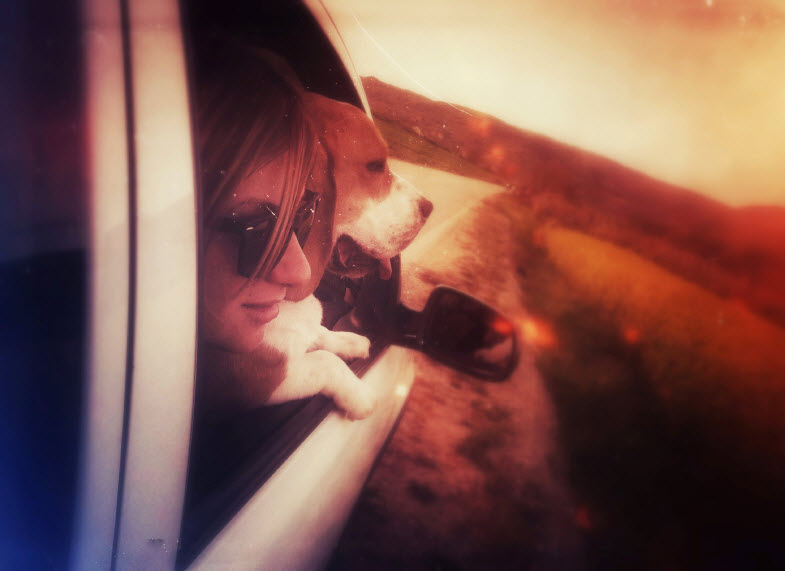How to Prepare Your Car and Dog for a Road Trip to the Grand Canyon
Dog owners truly are, if you’ll excuse the pun, a special breed. We consider these four-legged creatures our best friends and a part of the family. So, when it comes to taking a car trip with “Fido” there are several things you should know in order to keep you both safe and happy. With more people adopting rescue dogs, the number of owners is increasing greatly. While some of you are seasoned veterans of pet ownership, others of you are fresh novices who may not be aware of the pitfalls of taking your dog with you on a long car trip or vacation. It’s common knowledge among pet travelers that National Parks are not pet friendly. Pets are allowed outside of your vehicle, but only on paved parking lost and campgrounds. Unfortunately, trails are usually off limits. However, things are different at Grand Canyon South Rim. If your dog is leashed, it’s welcome on the South Rim Trail.
Regardless of your dog’s size, proper identification is the most important item to have before you finish packing. Losing your dog can put a real damper on your trip, not to mention putting his well-being in jeopardy. Keep the collar with current tags on at all times. A leash should also be worn as much as possible to lessen the chance of him getting lost in unfamiliar surroundings. If “Fido” has a microchip implant, all the better. Most shelters and veterinarians now have scanners to read them.
For added safety for both yourself and your pooch, use a doggie car seat. Yes, they actually do exist. A dog moving freely within a car can be extremely hazardous. In a sudden stop or evasive maneuver your pet could easily get hurt. And, if your dog is restless during the ride, passing from the front seat to the back can be extremely distracting and add to the possibility of an accident. Also, in some states driving with an unrestrained dog is illegal. A variety of different car seats are available…from small to large. Check into one for your trip.
When planning your Grand Canyon trip try to choose a route with a number of rest areas or parks along the way so Fido can take a bathroom break, stretch his legs for a few minutes, and burn off excess energy before getting back into the car and on the road again. Stopping approximately every three hours or so should be sufficient to keep your pet comfortable.
And, if you’re going to be traveling a great distance or overnight, locate dog-friendly hotels, motels, or campgrounds ahead of time, don’t wait until you’re on the road – it’ll be much easier and more enjoyable. Just remember to be respectful of others and clean up after your dog.
Don’t forget Fido’s looking forward to having a good time, too. That’s why it’s important to bring a few of his favorite toys, medications he may be taking, treats, food, water and a bowl. Now is not the time to experiment with a new dog food. Stay with his regular brand to avoid an upset tummy and what usually goes along with it. And, whatever you do, don’t feed your dog a large meal just before leaving and hopping in the car, especially if your dog is prone to motion sickness. Feed him a light meal no less than three hours prior to your initial departure, followed by very small meals until you’ve reached your destination. Don’t over fill his water bowl either or you could just be asking for trouble.
Under no circumstances should you leave your dog in the car, no matter what the temperature. Even on a mild summer day it takes as little as 15 minutes for your dog to begin experiencing symptoms of heat stroke. If that isn’t a deterrent, be advised that most states now have laws on the books making it illegal to leave a pet in a locked car. You wouldn’t want him to do it to you.
Traveling solo with your dog can obviously complicate things somewhat, which is why you may want to consider using the fast food drive-thru for your meals. You can stay with your dog and reassure him so he remains safe and contented. Should your plans include visiting places that don’t allow dogs, locate a “doggie day care” for the day. Do not leave him unattended in your hotel/motel room.
Although it’s been proven to not be good for them, dogs love to ride with their head out the window. Avoid this. Their mouth, eyes, and nostrils will dry out considerably from the wind. Once that happens, they will behave like a child – they will be uncomfortable and will probably make you as uncomfortable as they are by their whiny behavior.
The bottom line is, plan your trip wisely, follow these simple tips, and you’re bound to have a much better journey all around. And don’t forget to check car insurance off your list. If your dog is injured in a car accident while riding shotgun with you, it’s vet bill will be covered on an accident claim provided:
- The accident wasn’t your fault
- The negligent driver carries property damage liability. Your dog under this policy would be classified as personal property.
Have you taken long car trips with your dog? Feel free to share your thoughts in the comments section below.



